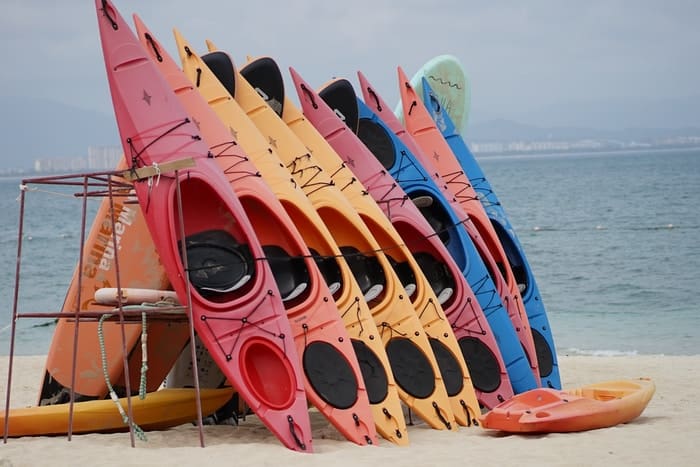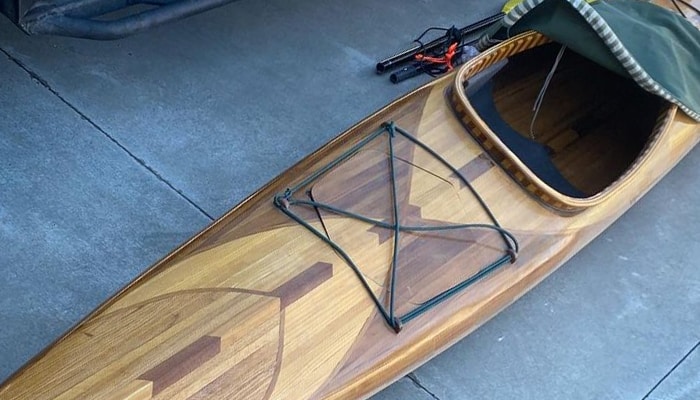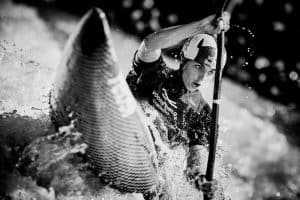Kayak construction has gone through several evolutions and developments through the years, and so have the materials used. Different construction processes and materials affect the performance and durability of a kayak. This is why it is essential to understand how kayaks are made in the first place.

So, what are kayaks made of?
Kayaks are available in different types, including composite kayaks, rotomolded kayaks, thermoform kayaks, wooden kayaks, and inflatable kayaks. Each kayak has its own application.
Read on below to know more about what kayaks are made of.
Composite Kayaks
The composite kayaks consist of those kayaks made from laminates of aramid fibers, fiberglass, carbon fiber saturated in resin, or a combination of these as well other kinds of advanced synthetic fabrics. Several manufacturers also integrate honeycomb or foam cores flanked by the layers of fabric for improved rigidity.
The key differences between the various composite materials used for kayak construction are their cost and weight, the priciest of which is the lightest material. Make sure you clarify which specific material a kayak is made of if it is listed to have a composite construction.
Aramid Fiber
The Kevlar brand and Aramid fiber are synonymous. Aramid fiber offers the same rigidity and strength as that of fiberglass. However, this one is cheaper is lighter. Fiberglass-aramid blends and aramid are more commonly used in weight-saving expedition kayaks, surf skis, and light touring kayaks.
Carbon Fiber
Out of the different materials that kayaks are made of, carbon fiber can be considered the lightest and happens to be the most expensive composite material for kayaks as well. Although this is often utilized for elite racing and sports kayaks, you can also find ultralight carbon touring and recreational kayaks.
Fun Outdoor Quiz
Fiberglass
Fiberglass is the tried and tested original composite material. Its affordable price and outstanding strength-to-weight ratio make it the most popular material of choice for many premium sea kayaks.
Rotomolded Kayaks
Without a doubt, rotomolded polyethylene is the material that kayaks are most commonly made of, at least as far as recreational kayaking is concerned. It has been this way since the 1970s when rotomolded kayaks were launched by Perception Kayaks for the first time.
Rotational molding is a term that pertains to the process of producing these plastic kayaks. Makers of rotomolded kayaks use plastic pellets transferred into the mold where it is heated then rotated inside a large “oven” until the inside of the mold is evenly coated with the melted polyethylene. This results in the formation of a one-piece kayak that is ready for outfitting and being used out in the water right away.
The process is a straightforward one where there is no need to fuse separate parts of layer materials, which explains the affordability of rotomolded kayaks.
Aside from their budget-friendly cost, these Tupperware kayaks are also a favorite thanks to their ability to resist impact. Thanks to the flex of these hulls, bending is more likely to happen than breaking.
Thermoform Kayaks
The thermoform kayaks are an excellent mid-range middle ground between composite and polyethylene kayaks. These kayaks boast cutting-edge plastic laminate construction to blend plastic’s durability and affordability with composites’ sleek feel, glossy aesthetics, and lighter weight.
Unlike composite construction, the manufacturing process of thermoform kayaks is notably less labor-intensive, making them priced just marginally above their rotomolded counterparts.
The process of thermoforming makes use of a vacuum for wrapping the kayak molds with heated sheets of plastic and allows designs to create finer lines as well as more complicated shapes and uses fewer materials compared to rotomolding.
The use of fewer materials not only improves efficiency but also creates a lighter-weight kayak. The hull and deck are thermoformed individually before they are trimmed, detailed, then merged with tape and adhesive at the sheerline.
The unique plastic sheet used to produce thermoformed kayaks combines one or more glossy acrylic thin outer layers with an ABS plastic base layer that is known to be resistant to impact. It is this shiny, UV-, and acrylic cap resistant to scratches that is responsible for the stunning finish of thermoform kayaks.

Wood Kayaks
Off-the-shelf wood kayaks are not that common because they aren’t as mass-produced as other modern kayaks are.
These kayaks are often products of craftsmanship, manual labor, and DIY projects with two popular construction styles.
The stitch and glue method doesn’t need advanced skills in woodworking. However, you need to cut plywood into preferred shapes, use wire to stitch the pieces together, and glue everything, which explains the name.
Cold-molded or strip-built wood kayaks are made by binding wood strips altogether around the temporary frames, allowing endless possibilities in terms of design.
After the wood is assembled, this is coated with the defensive layers of resin and fiberglass and often covered with a varnish finish. It offers protection for the wood as it prevents warping and minimizes the harsh effects of water damage.
As a material that a kayak is made of, wood is most notably for its durable but lightweight nature, endless options for design, stunning beauty, and relatively affordable cost, as long as you make one on your own. if not, expect that a wooden kayak will cost you more.
Inflatable Kayaks
Inflatable kayaks are made of rubber-like and softer materials. These are meant to endure high inflation pressures and let the kayak deflate and float if not in use, something impossible with a composite or plastic hull. Three materials are most commonly used for inflatable kayaks.
Hypalon
DuPont’s patented synthetic rubber, Hypalon, is a high-performance material notable for its ruggedness and resistance to abrasion, mildew, extreme temperatures, and UV radiation. Out of the three advanced kayak materials, Hypalon is often reserved for high-end inflatable kayaks which explains their prices that are also higher than average.
Nitrylon
Inflatable kayak manufacturers are starting to tap into more eco-friendly alternatives to PVC like Nitrylon. The 1200-denier polyester fabric and the lamination of synthetic nitrile rubber are shown to be more resistant to punctures and abrasion and are also more reliable compared to PVC. However, due to its weight, it is often found on the bottom and sides of inflatable kayaks.
PVC
PVC or polyvinyl chloride holds the title as the most popular material that inflatable kayaks are made of. This is relatively lightweight, cheap, and can also be bonded to other types of materials like nylon for better resistance to tear and improved strength. But it has some sensitivity to high temperatures and UV damage and is not good for the planet, too.
Now that you know what kayaks are made of, be sure to choose what suits your needs and of course, your budget.









